Chantal Marquart
-Storytelling
-Research
-Coding
In Kenya, human rights violations by the police have become an endemic problem. Over the last decade, Kenya’s security agencies have repeatedly been accused of corruption, complicity with criminals, and violating human rights. With the emergence of anti-terror laws in the wake of rising islamist terrorism, these accusations have become even louder. In response, human rights organizations have monitored and documented several hundred cases of enforced disappearances and extrajudicial killings, most of them allegedly disguised as part of anti-terror operations.
Based on expert interviews and previously unpublished data gathered by Amnesty International Kenya, we investigate the potential systematic targeting by security forces and provide possible explanations for these patterns of violence focusing on the historical distrust between Kenya’s Muslim population and the state, the police’s counter-terrorism approach, and weak accountability structures within the police.
This website is part of the UZH Democracy, Development, and International Relations Capstone Project of Fall 2017. The project works in collaboration with Amnesty International to research the political and social context of human rights violations by Kenyan security agencies. The analysis below presents our findings.
Abdirahman Ahmed Dakane, a teacher in Garissa, Kenya, was arrested at work in August 2015 by police officers attached to the Kenyan Anti-Terrorism Police Unit (ATPU). The 30-year old man of Somali origin had been working with the US-organization Advocates for Human Rights to seek justice for victims of police violence in Garissa County. According to eyewitnesses, Dakane was arrested for cooperating with the enemy outside Kenya. The officers beat him up and hauled him away. Dakane has not been seen since1.
The case of Abdirahman Ahmed Dakane is just one example of violence against civilians by the Kenyan police- and security forces. Between the years of 2011 and 2016 human rights organisations, newspapers and other independent agencies collected several hundred witness statements of police violence or violence against civilians. The 323 human rights violations in our database include arbitrary arrests, extortion, illegal detention, torture, killings and disappearances. In total, we found 127 so-called enforced disappearances and 112 extrajudicial killings in the 5-year-period. The victims were often rounded up and detained for hours or even days without any legal basis. Many of them had also been tortured while in detention.
Out of all the reported incidences, most victims were men aged between 20 and 40. In only four percent of the reported cases the victims were women. Over half of the 323 cases occurred in a context of counter-terrorism. The alleged terrorists are often linked to the Al-Shabaab movement or are suspected to have taken part in a terrorist attack.
Upon taking a closer look at the people suspected of terrorism, it becomes clear that a high percentage of the suspected terrorists are Muslims (75 percent) or at least carry a Muslim name (95 percent). Hussein Khalid, Executive Director of the Kenyan Human Rights Organisation Haki Africa, acknowledges these findings. “When it comes to terror-related killings, I expect over 90 percent of the victims to be of Muslim faith”, he says. According to him, this has partly to do with the fact that many of the people engaging in terror activities are indeed of Muslim faith. The link of human rights violations to anti-terrorism operations, however, is a lot less prevalent in cases of enforced disappearances compared to extrajudicial killings.
These results might be a first indication of the abuse of anti-terror laws by the police. Many human rights groups claim that since the introduction of anti-terror measures, the Kenyan police have covered up human rights violations committed by security agencies under the guise of counter-terrorism operations. „The anti terror-laws we have in Kenya have given the police power to disregard human rights and fundamental freedoms“, Hussein Khalid states.
Some observers have gone a step further and claimed that, rather than mitigating terrorism in the country, Kenya’s counter-terrorism measures have led to an increase in physical insecurity and religious radicalization. “The human rights violations by the police, raids of places of worship and the passing of retrogressive anti-terror-laws have made the situation of radicalization2 even worse”, says Hussein Khalid. In his opinion, a soft approach that would bring in religious or community leaders, or even politicians, to speak to communities and introduce alternatives to radical ideologies, would have better chances of succeeding at preventing terrorism.
The reported cases, though, are just the tip of the iceberg, and the dark figure is estimated to be a lot higher. Many cases are not reported, often due to the simple fact that certain communities can not reach human rights organisations because they live in remote areas. However, for Khalid the main reason why so many cases go unreported is a different one, namely “that a lot of people are afraid of handing in witness statements has to do with the fact that we do not have a friendly police service”. Information could be leaked or misused by the police. “We had cases where people who were reporting to us were put in dangerous situations.” The legacy of police violence in Kenya and the fact that weak accountability structures and corruption secure the power of the police might further weaken the trust of the citizens in Kenyan security services.
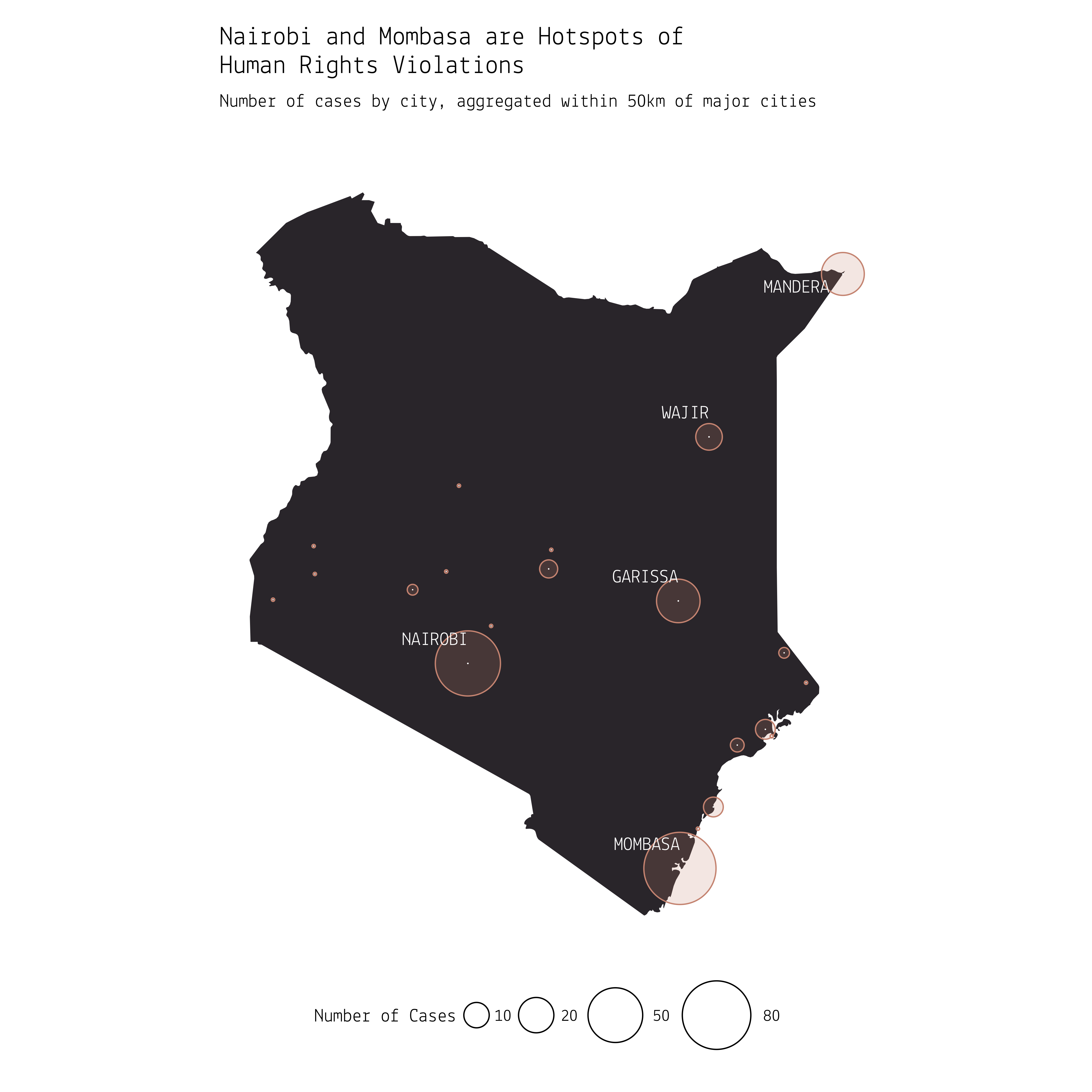
The fact that a lot of cases go unreported might also influence the regional distribution of the cases. Most violent encounters were reported in the big cities like Nairobi, Mombasa or Garissa. When looking at Muslims specifically, most human rights violations by Kenyan security forces are reported in three regions. First, there is the former Coast Province, which today consists of the Mombasa, Kwale, Kilifi, Tana River, Lamu and Taita-Taveta counties. Most of the cases, however, are found in the city of Mombasa. Another hotspot is northeastern Kenya and its counties Mandera, Garissa and Wajir. Furthermore, one of the biggest number of victims within a single county was found in Nairobi.
In Mombasa, Garissa and Mandera especially, the number of Muslim victims is high, with 97 percent of the victims being identified as Muslims. The reasons for this are twofold. On the one hand, most of the human rights organizations that reported incidences of excessive police violence against Muslims are located in those regions. On the other hand, these regions are historically inhabited by large Muslim communities and are a hotspot for radicalization, in part nourished by a legacy of marginalization.
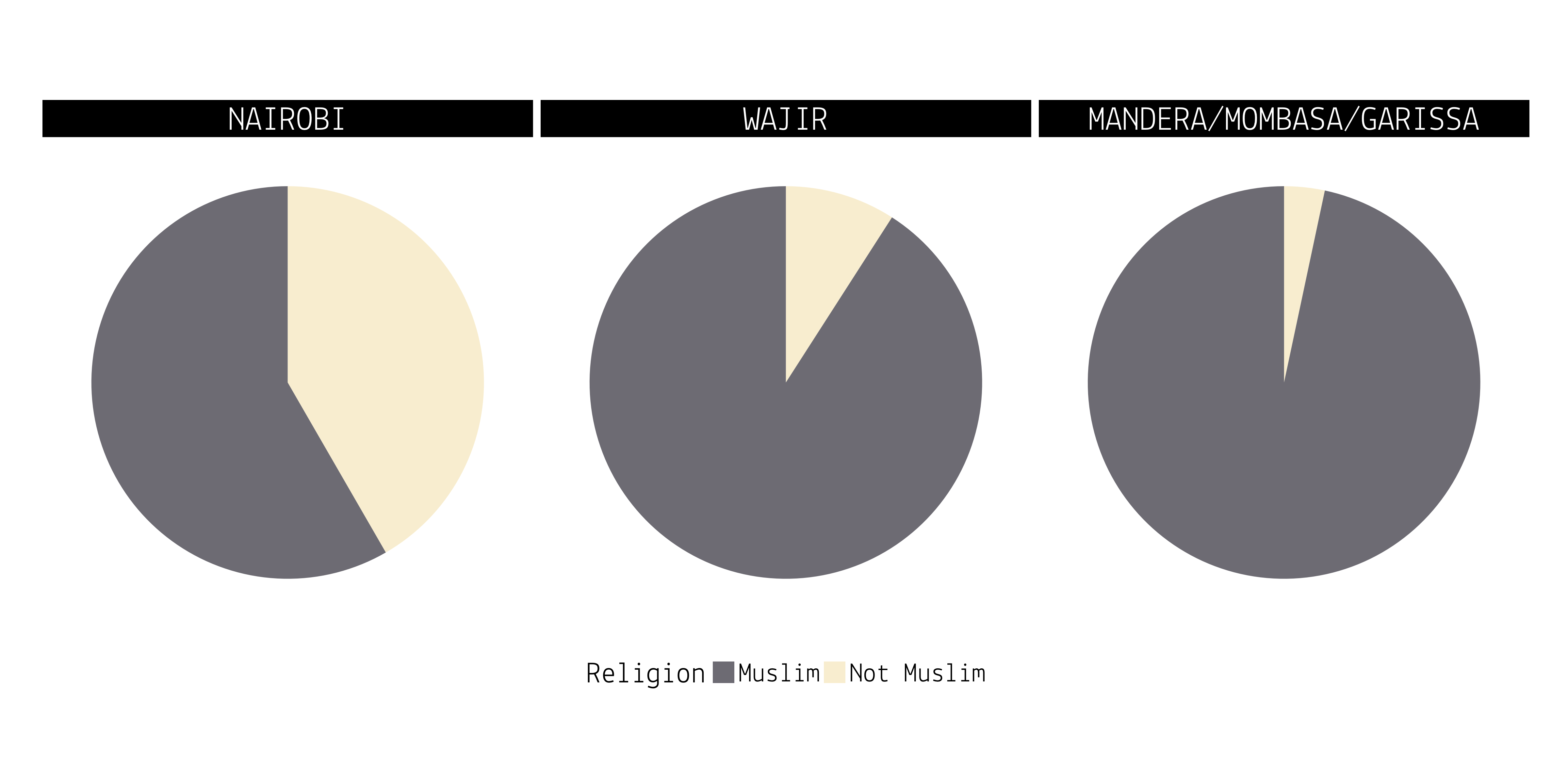
The relationship between Muslims, the Kenyan state and its security forces has always been tense and shaped by prejudices. Hassan Mwakimako, an associate professor of Islamic Studies at Pwani University in Kilifi, explains: “For a long time, Kenyan Muslims have felt alienated from the state and are under the impression that the state has marginalized their communities.”
Ten percent of Kenya’s population belong to the Muslim faith3. Although nominally secular, Kenya is often described as being “in practice a Christian state” due to the mainly Christian personnel in administration and politics or because of the role the Christian faith plays in political addresses to the public4. This tense relationship is not only limited to the state and is most probably rooted in historical cultural prejudices against Muslims. The recent increase of terrorist attacks in Kenya and around the world has hardened the already existing anti-Muslim perceptions among many Kenyans5.
In Kenya, hostility towards Islam often focuses on the Somali people living there. Mostly Muslim, they are perceived as “Kenya’s most intimate enemy” - a result of a history of mutual distrust and violence between the Kenyan state and its ethnic Somali population. This relationship has worsened with the arrival of an increasing number of Somali refugees who flee civil war in their home country and with the threat of terrorist attacks by Al-Shabaab, a terrorist group based in Somalia6.
Kenya’s ethnic Somali population predominantly resides in the three northeastern counties of Mandera, Garissa and Wajir, which are recognized to be amongst the fourteen most marginalized regions in Kenya7. Having been under British control since 1925 but originally once part of Jubaland (in present-day southern Somalia), the regions were integrated into the newly independent Kenyan state in 1963. This happened despite a strong preference among the population to join the newly formed Somali Republic. During the resulting Shifta War (1963-1967) and the Emergency Rule upheld until 1991, Kenya’s ethnic Somali population was a target of collective punishments, massacres and the so-called “forced villagisation”, a resettlement of scattered communities that took place to gain better control of them8.
The fact that 58 percent9 of all the refugees in Kenya come from Somalia fosters fear and mistrust within the Kenyan population. Repeatedly, the Kenyan government has tried to shut down refugee camps by raising concerns about security and the threat of terrorism from the Somali terror group Al-Shabaab that poses a constant threat to Kenya’s security. The fact that the press coverage increasingly connects Somali people to those security issues has helped confirm, not improve, their reputation for being defiant, unreliable and ‘foreign’10 11.
The prejudices against people of Somali background also affect other Muslim groups that mainly live in Kenya’s coastal provinces. Similarly to the northeastern region, the coastal population has a precarious relationship with the Kenyan state. The narrative of marginalization there mainly focuses on the concept of land tenure, which affects both Muslims and Christians12. Until today, inequalities in land distribution are a massive problem in Kenya, especially in the coastal areas, where vast parts of the prime land is owned by absentee landlords from prominent political families, leaving almost 130’000 people as squatters. Muslim communities and especially religious or political leaders have often used the consequences of coastal dispossession to stress the discrimination of Muslims in Kenya13.
Indeed, a 2013 published Final Report of the Truth, Justice and Reconciliation Commission of Kenya laments the under-development of Muslim-inhabited communities, their underrepresentation in national politics, educational shortcomings and employment-related disadvantages. The main issue for Muslims, however, is the access to national Identity Cards. Kenyan Muslims are often exposed to vetting and harassment when applying for them. Yet, in Kenya, IDs are imperative when registering as a voter, receiving governmental services, enjoying the right of free movement, possessing property, or applying for universities. Furthermore, inhabitants of the northeastern provinces in particular are unproportionally checked at police controls, where the possession of an ID is mandatory14.
[Kenya: Killings, Disappearances by Anti-Terror Police, Human Rights Watch]
Hassan Mwakimako confirms that Muslims and particularly Somali are oftentimes targeted by the police based on cultural profiling, a practice which focuses on stereotypes. “There have been attempts to use the law to profile Muslims and sometimes even undermine their rights”, says Mwakimako.
Contributing to this issue is the ethnic deployment of high-ranking police officers across the country. This strategy is mostly applied during periods of unrest, including the aftermath of terror attacks, or in times of elections. “Officers aligned to the incumbent or the regime in power are deployed mostly in areas dominated by ethnic communities that are perceived to be opposed to the presidency or that regime”, Stars-journalist Ramadhan Rajab explains. According to Hassan Abdille from Muslims for Human Rights (MUHURI) this strategy is also implemented in the coast region, a traditional opposition stronghold: “During the elections we had only two communities deployed here from the police. The president’s family and the deputy president’s tribe. All the police heads were coming from those communities.”
The historically tense relationship between Muslims and the state has continued to deteriorate following an increasing number of terrorist attacks and counter-terrorism operations in Muslim-majority regions. As a frontline state in the global war on terror, Kenya has beared the greatest brunt of terrorism in the region. Terrorist attacks in Kenya increased dramatically in October 2011, after Kenya deployed its military to Somalia on its northeastern borders in an attempt to weaken Al-Shabaab and hinder its capacity to launch attacks in Kenya15. Since then, there have been multiple devastating attacks in Nairobi as well as in the coastal and northeastern regions in Kenya. Among the most deadly were the Westgate Mall Attack in September 2013, the Lamu Attack in June 2014, and the attack on the Garissa University College in April 2015 in which 148 students were held hostage and killed16. There were also attacks on the Kenyan Defense Forces deployed in Somalia, as occurred on January 2016, when Al-Shabaab allegedly killed over 100 KDF (Kenya Defense Forces) soldiers in the Battle of El Adde17.
The frequency and magnitude of the attacks have exposed Kenya’s vulnerability and weak defense capacity. With key industries such as tourism stalling, Kenyans are calling for greater security measures across the country18. In the face of such a challenge, the Kenyan government has adopted security measures to contain the threat of terrorism, which have been in part funded with financial aid from countries like the US, the UK and Denmark. Since Kenya is considered a regional anchor state in the Horn of Africa and a strategic ally to the West’s counterterrorism efforts in the war on terror, these Western countries also provide Kenya with legal advice and training in counterterrorism operations19.
With funding provided by the counterterrorism initiatives, the Kenyan government has established two major terror-fighting organizations in the last decade: the Anti-terrorism Police Unit (ATPU) and the National Counter Terrorism Centre (NCTC). The ATPU is the main Kenya Police unit responsible for responding to and investigating terrorist activity, while the National Counterterrorism Centre coordinates all government counterterrorism efforts20.
In addition to these organizations, the Kenyan state has also taken legal measures to fight terrorism within its borders. In 2012, a new bill called the Prevention of Terrorism Act was passed in an attempt to readdress terrorist security threats21. The Prevention of Terrorism Act remains the main legal framework through which counter-terrorism measures can be affected in the country, although several amendments were ratified following criticisms by members of the Muslim community and several human rights groups.
Court judgements against suspected terrorists, however, are rare. It seems to be too difficult to gather enough evidence-based information and to find witnesses willing to testify in court22. Instead, anti-terrorism security forces like the ATPU have used the fight against terrorism as an excuse for the excessive use of force as happened to Abubakar Shariff, a prominent and controversial Islamic cleric who had faced several terrorism charges in court, but could never be convicted. He was finally killed leaving a courtroom23. In addition to this, critics are concerned that due to overly vague definitions of terrorism, police forces could potentially expand their power against political opponents, civil society, religious and ethnic groups, minorities, or any other vulnerable group24.
[Kenya: Killings, Disappearances by Anti-Terror Police, Human Rights Watch]
A closer look at our data indicates that human rights violations by the police increase especially when the threat of terrorism in Kenya is high. Comparing the number of human rights violations recorded in our database with the number of terror attacks that happened in Kenya per month, we see a strikingly similar trend. Contrasting the peaks in the trend lines, it is interesting to see that the peaks occur more or less at the same time. However, the peaks in the count of recorded human rights violations become larger over time, while the peaks in the number of terror incidents stay relatively stable. This might indicate that the police has indeed been abusing anti-terror laws more frequently in the recent years.
It is important to note that an increase in human rights violations could also be attributed to the fact that most reports used to collect data date from 2015 and 2016 and therefore may cause an overrepresentation of more recent cases. What is more, comparing the peaks it could be argued that counter-terrorism operations sometimes are sheer reactions to attacks, rather than carefully planned operations against terror-suspects. This impression is shared by Hussein Khalid: “The police is reacting to terror attacks in knee-jerk operations that should show the public that they are actually doing something against the threat of terrorism. However, there is no system in place in these operations.”
“The police is reacting to terror attacks in knee-jerk operations that should show the public that they are actually doing something against the threat of terrorism. However, there is no system in place in these operations.”
Khalid further claims that the police are likely to have used major terror incidents as a cover up for other actions. “Haki Africa was shut down after the Garissa University attack. Moreover, after the Westgate incident, the government opened up a concentration camp of some sort where people of Somali origin were put for days”, he says, referring to Usalama Watch. This operation was carried out in spring 2014 and lead to the arbitrary arrest, relocation, harassment and expulsion of hundreds of Somali immigrants locating in Nairobi’s Eastleigh district25.
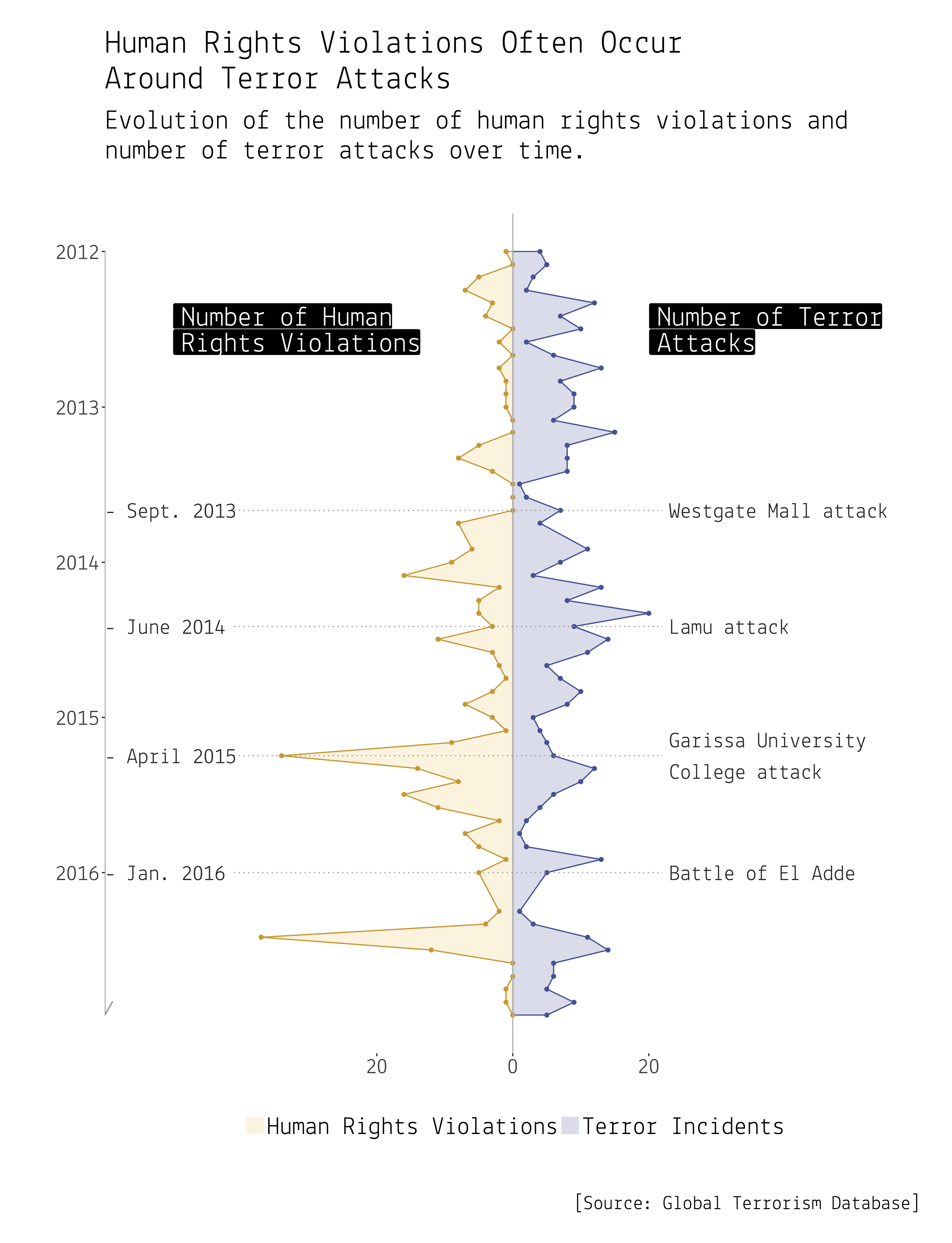
According to Hassan Mwakimako, the introduction of the anti-terror bills has led to an increase of violence against Muslims in Kenya and to a suppression of their rights. “The war on terror has led to arbitrary arrests and disrespect to the Muslim traditions. Policemen were sent to several Mosques and distracted prayers or even detained clerics who they said to be radicalizing members of their community.”
Although some of the Muslim victims targeted by the police were either proven or suspected terrorists, human rights groups have found that security forces appear to indiscriminately target Kenyan and Somali Muslims, regardless of their age or affiliation to terrorist groups. “Muslim communities in Kenya are considered to be suspect communities”, says Hassan Abdille. “Muslims are specifically targeted by the police and go through a lot of harassment. This is why they are feeling marginalized, oppressed and victimized.”
“We have had incidents where people have fights on different issues and will then report their opponent as being involved in terror, because they know that once you are tagged with that, the police will do anything.”
A Human Rights Watch26 report published in 2014 revealed that a police raid intended to capture Islamic extremists unfairly targeted innocent civilians. Professor Mwakimako confirms these findings and sheds further light on the situation: “In the event of any terrorist attacks, usually the reaction of the police is to arbitrarily arrest people, to arbitrarily get into people’s houses and in many cases to destroy people’s properties. Muslims that are within the vicinity of where the terrorist attack has happened are most likely going to suffer”, he says. “Even if these people live very far away from the locations of the terrorist attacks, police will go after them and accuse them of involvement in the attacks."
[The error of fighting terror with terror, KNCHR]
Hussein Khalid complains that as soon as the police considers someone as a terror suspect, they are as good as guilty. “Once you are declared a suspect, you lose all your rights and the police can do whatever they want. As a terror suspect, you are guilty until proven innocent.“ He also claims that this problem has begun to spill over to civil society and has now even been used to get rid of business rivals. “We have had incidents where people have fights on different issues and will then report their opponent as being involved in terror, because they know that once you are tagged with that, the police will do anything.”
Even though the ATPU is specialized in carrying out counter-terrorism operations, it is by far not the only unit involved in fighting terrorism. The data analysed for this article reveals the presence of many other security forces, namely units of the National Police Service like the General Service Unit (GSU) and forces merely described as ‘Police’ as well as units belonging to the Administration Police, such as the Rapid Deployment Unit (RDU) and the Border Patrol Unit (BPU). In addition to this, the Kenya Police Reserve (KPR), the National Intelligence Service (NIS), the Kenya Wildlife Service (KWS) and the Kenya Defense Forces (KDF) are reportedly active in counter-terrorism operations27.
Whereas the multi-agency strategy might be a reasonable approach from a security perspective – especially since the police-public ratio in Kenya is low28 – it proves disastrous for civil society and human rights organizations seeking to follow up on claims of excessive use of force. Hassan Abdille stated during an interview that his team was initially “completely confused” by the presence of the many agencies. He believes that the multi-agency approach is a means to distract from the actions of the ATPU, which has been exposed to and whose work has been criticized heavily by the public. “If someone from the KWS kills an individual, people will think that this person must have been suspected of crimes like poaching”, explains Hassan Abdille, since poaching is a severe crime in Kenya and can be punished with heavy fines or life sentences. As reported by various newspapers, Kenya’s government is even considering the introduction of death penalties for poachers29.
On the other hand, it is is widely stated that various security forces use the counter-terrorism context as a cover-up strategy. An Al-Jazeera documentary on this issue stated that victims of police violence are often called “terrorists” as a way to ward off questions posed regarding excessive use of force. Philip Alston, former United Nations special rapporteur on extrajudicial, summary or arbitrary executions, contends that it is a standard strategy for the police to create shootout scenarios at crime scenes, even when the persons killed were unarmed30. This is contributing to the high number of agencies involved in “counter-terrorism operations”.
[We are Tired of Taking You to the Court, Open Society Forum]
Most importantly, the multi-agency approach of the Kenyan security services hinders the efforts of human rights organizations to follow up on citizens’ complaints of excessive use of force by the police. Both witnesses and victims are sometimes unable to recognize the security forces involved because they often do not show a form of identity such as a badge. To make matters worse, some of the security forces wear similar camouflage uniforms and drive unmarked vehicles31. Since the jurisdiction of the security forces also remains unclear, it is usually difficult to identify the respective forces.
Overall, the data we analyzed indicates that the ATPU, the KDF, and the regular police are the three main players in counter-terrorism operations. These three units were involved in almost 70 percent of all cases, which could be due to the circumstance that the KDF, the ATPU and the Police are the only forces operating in all parts of the country.
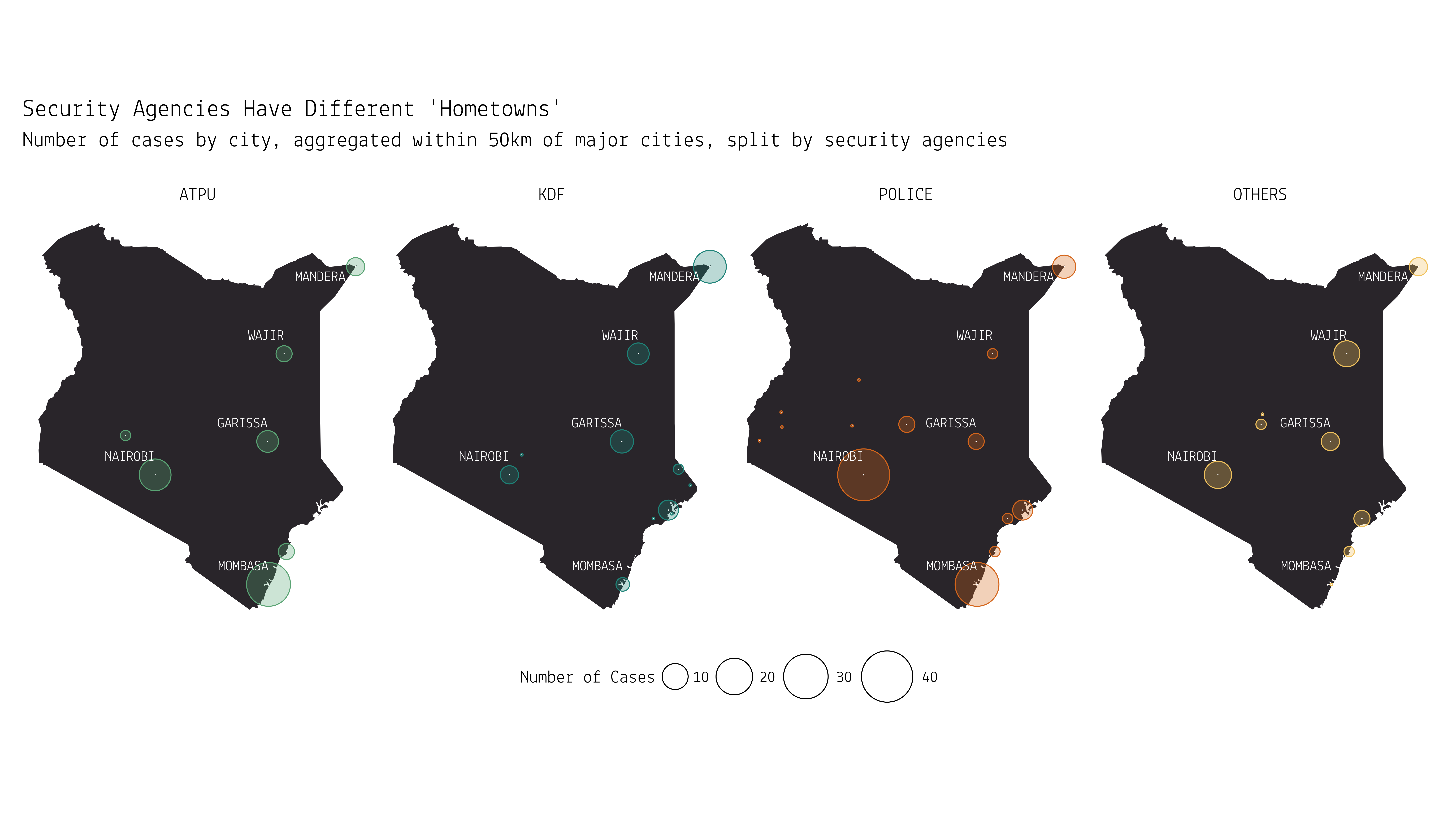
The regional distribution of the cases shows that the KDF is mostly involved in the coastal and northeastern part of Kenya. The northeastern cities of Mandera, Wajir and Garissa are described as “violent extremism hotspots”32 due to their proximity to the porous border with Somalia. Consequently these cities historically have had a high military presence and a particularly low police-to-public ratio.
[The Error of Fighting Terror with Terror, KNCHR]
The domestic deployment of the KDF, which is predominant in those cities, is only allowed in situations of unrest or instability to restore peace as well as in cases of emergency or disaster in order to assist other authorities. Both actions have to first be approved by the National Assembly and then issued in the Gazette, the official publication of the government of Kenya. These requirements have not been met so far. It seems that police officers often feel intimidated by military personnel and are unwilling to investigate abuses committed by the KDF. And what’s more, the Independent Policing Oversight Authority (IPOA), an organisation entitled to investigate misconducts by the Police and enhance professionalism within the National Police Service, has no mandate to investigate KDF misconducts either.33
Concerning cases of extrajudicial killings and enforced disappearances of suspected terrorists, the ATPU and the police are each responsible for around 30 to 38 percent of the reported incidences. Rather strikingly, the police is also accused of having been involved in 77 percent of executions of individuals who had no clear links to terrorism. These figures confirm an image of a ‘trigger-happy’ police described by Hassan Mwakimako and Khalid Hussein and several other observers. When it comes to the enforced disappearances of people who had no clear and confirmed links to terrorism, 45 percent of these cases could be attributed to the the police. However, the KDF and the ATPU are also accused of having participated in 23 percent and 17 percent of enforced disappearances, respectively. This leads to the conclusion that the ATPU and the KDF operate primarily on issues related to terrorism, especially when it comes to killings – although in the case of enforced disappearances, they also target people with unclear links to terrorism-related activities. The picture that can be drawn of the police, on the other hand, confirms the argument that the excessive use of force by Kenya’s security forces is deeply entrenched in the system.

Indeed, the use of excessive force used by the Kenyan security forces to fight terrorism is highly related to general police violence in Kenya. The Kenyan police is rated to be the third worst police force in 2016 in the World Internal Security & Police Report. This ranking was mainly justified by high corruption and excessive use of force as well as low capacity and restricted access to resources34. There were complaints that the Kenyan police efforts lack a research-led approach, strategies of intelligence gathering and careful analysis and that the slow adoption of information technologies hinder information sharing between the units. Accordingly, trust in the police is low. One in every three Kenyans claims to have experienced some sort of police misconduct or abuse35.
“If one was to be given a choice to find themselves in a dark alley with either the police or a robber, Kenyans say that they rather have the robber than the police officer.”
Hussein Khalid cites a popular phrase claiming that “if one was to be given a choice to find themselves in a dark alley with either the police or a robber, Kenyans say that they rather have the robber than the police officer.” Likewise an IMLU-report states that there are more chances in Kenya to be killed by a police officer than by any other person. Furthermore, the police department is said to be the corruptest department in the government36.
According to Ramadhan Rajab, journalist from the Nairobi based news agency The Star, excessive use of force is not only a consequence of poor policing strategies, but can be traced back to colonial times. “It seems as if the Kenyan police has not dropped the colonial mindset of policing”, he says. “The police officers think they can only enforce the law through violence.” Philip Alston confirmed in a 2009 report37 that violence is deeply entrenched in the Kenyan police sector. Alston concluded that “police in Kenya frequently execute individuals and that the climate of impunity prevails. Most troubling is the existence of police death squads operating on the orders of senior police officials and charged with eliminating suspected leaders and members of criminal organizations.”
[Error of Fighting Terror with Terror, KNCHR]
Partly as a reaction to Alston’s report but mostly triggered by increasing criticism within Kenya, there have been constitutional changes of the police system, including staff turnover, the installation of the Office of the Director for Public Prosecutions , and the establishment of the Independent Police Oversight Authority (IPOA)38. Complaints from both members of the public and police officers are collected and analysed by the IPOA. Every six months the IPOA is supposed to summarize these reports and inform the public of its activities and provide recommendations for improvement of the functioning of the National Police Service.
Although the IPOA has been operating since 2012, police violence is still prevalent. According to Ramadhan Rajab, changes brought about by the reforms are not yet sustainable. “Even though the young police officers might be trained in modern ways of policing – without the use of excessive violence – when they come to the field, they get in contact with the older senior police officers who believe in violence as the ultima ratio”, he says.
For Ramadhan Rajab, the issue of police violence is an issue of impunity. “It’s not like the officers are legally immune”, the journalist says. “But the problem is that external oversight authorities like the IPOA rely on police to gather information and evidence in order to nail officers who have violated the law.” This is – according to Ramadhan Rajab – highly problematic, because the commanders who are supposed to give evidence to the IPOA to allow them to prosecute criminal officers, do not always report. “So the criminal officers still walk around”, the journalist says. “Sometimes they even commit crimes with the blessing of the top commanders.”
“It seems as if the Kenyan police has not dropped the colonial mindset of policing”
Hussein Khalid and Hassan Abdille share this view. Khalid complains that none of the 81 cases his organization had handed over to the IPOA in 2016 has been investigated until 2018. He does not blame IPOA itself that “has done its bits”, but the government which has “intentionally under-resourced them”. A look at the institution’s “End-Term Board Report 2012-2018” confirms this assessment: From the 5085 cases received for investigation 64 were before courts at the time of publication and in only 3 cases had a conviction been made39. Both Abdille and Khalid agree that there is “zero accountability in the police force”. It is “absolutely terrible”, Abdille emphasizes.
There are several aspects of policing that need to change in order to ease this tense situation. For one, experts agree that the accountability process of police officers has to be reformed further. “Our accountability issues with the police are a cancer we urgently need to deal with”, says Hassan Abdille. For him, accountability processes are especially weak for ethnic-related reasons as well as corruption. “Sometimes we fail to hold the police accountable because of corruption and impunity in the system and because we value ethnicity more than the issues of torture, extrajudicial killings and enforced disappearances within the police. And people are protected because of their ethnic backgrounds”, he says.
According to Ramadhan Rajab, when it comes to policing, not only the functionality of the IPOA but also the one of the Internal Affairs Unit (IAU), the Internal Affairs Unit , has to be improved. “The IPOA does not always have access to police reports”, the journalist says. “So what needs to improve is the police commander accountability, meaning the accountability processes within the police itself. And we have to make sure that these officers who have been abusing human rights and been bribing legal authorities are not in the system anymore.” Only then, reliable accountability structures can be established.
Another aspect of the systemic problems within the Kenyan police forces are the small size of police forces and the poor training officers receive, especially of top commanders. „The police has to be taken through leadership and management trainings“, says Hassan Abdille. „Because the senior officers that are in office for a long time, have not had proper training in human rights issues and leadership structures.” Furthermore, efforts of reducing the level of corruption within the police force should be intensified. Although the Kenyan government has carried out some anti-corruption reforms, these do not seem to have the intended effect.
Especially when it comes to counter-terrorism operations the experts are sure that changes are necessary. “Of course we can not advocate for terrorists”, says Hassan Abdille. “But we must be able to apply the rule of law. We must be able to justify and give proof and evidence that a person is actually a terrorist. So far, that does not happen in Kenya.” One solution to the problem would be to introduce harsher background checks and proper investigations of alleged terror related activities.
Furthermore, a soft approach to countering violent extremism should be promoted, where the security forces work closely with the communities in order to tackle radicalisation. Only in 2016 did Kenya launch a National Strategy to Counter Violent Extremism (NSCVE). The strategy calls “individuals and groups at the national and community level” into action and aims to complement the existing security-focused measures with a soft approach consisting in the provision of employment options and business opportunities amongst others to reduce youth vulnerability to extremism40. However, the NSCVE is still in its early stages and faces various difficulties. Consequently, it is defeated by the hard approach of the global war on terror and by the acceptance of the excessive use of force when it comes to targeting terrorists.
Many independent organisations, such as Haki Africa, have initiated anti-radicalization programs in coordination with the government, but nevertheless the killings and disappearances are continuing. “Only a few days ago an 18 year old guy was picked up by unknown police officers and has not been since”, says Hussein Khalid. “And then two Somali were shot dead in Kwale for alleged links to Al-Shabaab. These are things that really take us back.” In general, it seems as if improvements in countering terrorism in Kenya are frequently stifled by endemic and persistent structures that enable police violence. So without fundamental reforms of the security sector, police violence is likely to persist.
In the following section you will find information on the data used.
Our external capstone project partner, Amnesty International Nairobi, provided our team with a large record of extrajudicial killings and enforced disappearances that have occurred in Kenya. Amnesty International, together with other global non-governmental organizations, has successfully documented a total 375 cases of extrajudicial and enforced disappearances that have occurred in Kenya since the 1990s. These have served as the basis of our analysis that focuses on the time period from 2011 to 2016.
The primary sources of the data collected by Amnesty International can roughly be divided into two groups: reports from Human Rights Organizations and reports from newspaper articles. In addition to the original database provided, cases from other sources were included into our analysis. (A list of all the sources can be found here).
Cases mentioned in the human rights reports but disregarded in the original database by Amnesty International were included in the final database as well. Duplicates in the database were avoided by only adding victims that could be clearly identified.
In order to structure the data for our analysis, we created a standardized codebook consisting of 32 variables. The codebook contains sociodemographic variables like age, gender and occupation, as well as person-specific variables like religion, a suspected Mungiki, and a suspected terrorist. The current status of a person “meaning whether a person is at home, missing or dead” is coded as well. Additionally, incident-specific variables like the date and location of the incident and information about the security agencies and the officers involved in the incident were coded. Coding included information on whether the incident was part of a counter terrorism act and whether the incident could be classified as an enforced disappearance or an extrajudicial execution. Finally, information about the sources and the coder are listed.
Overall, 140 new cases were added to the original database, increasing the total number of cases in database to 515. For this article, however, only the data of the time period between 2011 and 2016 was taken into account. This is in part due to both political and social circumstances in Kenya and due to our research focus, as well as for the sake of robustness of the data since information is only consistently available within this specific time frame. Therefore, in this article, only 323 out of the 515 cases were considered for our analysis. From these cases around one third are cross validated by at least two sources.
Due to the nature of our sources there is unfortunately no complete information on all the cases. The graph on missing values in our data shows that we mostly lack information about age and occupation of the victims. Also, the number of agencies involved and the names of the agencies involved is sometimes missing. This might be due to the problem of the multiple agency approach used by the Kenyan State, as mentioned in the article.
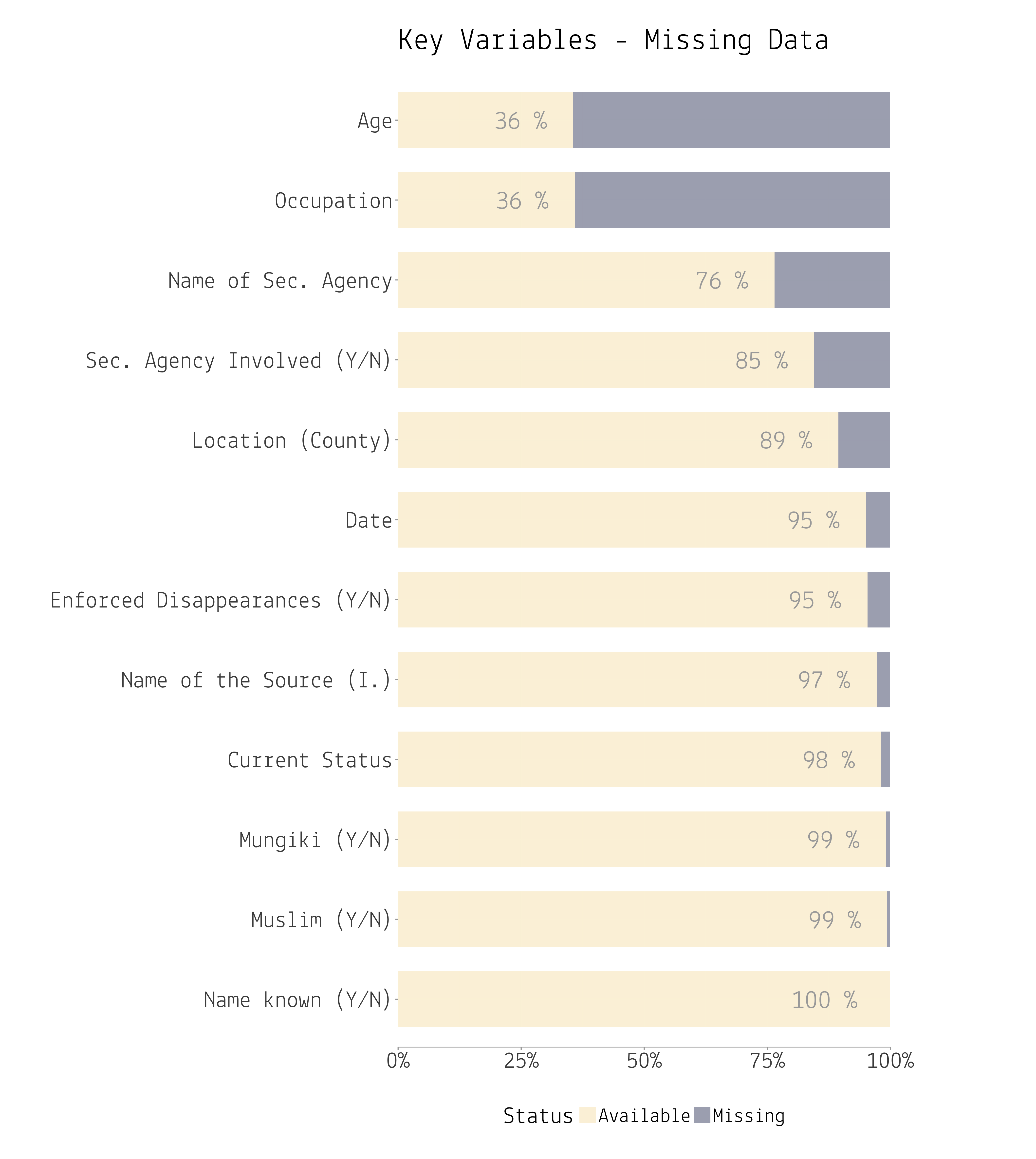
The characteristics of our data and its sources lead to a considerable amount of uncertainty in our analysis. First of all, it has to be clear that the number of cases analysed are only the tip of the iceberg. A lot of the cases of police violence never get reported, neither to the state organs, nor to human rights groups. This might be because of fear of repercussions or because those people can not reach any institution to hand in there reports because they live in remote areas. On top of that, our data and the reports used are focused on counter terror operations and violations happening around them, however the problem is not limited to this. Excessive use of force by the police is a general problem in Kenya, as we have shown in our article.
The fact that a valid amount of our cases are from newspaper sources brings its own set of challenges. First, Nairobi, the city where most newspapers reside, is probably overrepresented in the cases reported by newspapers. Secondly, since newspapers are probably not as detailed in their case descriptions as the human rights reports, there seems to be a high number of cases were the police, as a general term, is named as perpetrator. Also, since newspaper do not have a focus on counter terrorism, like the human rights reports, a high number of cases obtained from newspaper articles are concerning victims that are no suspected terrorists. Combined with the first point made about Nairobi, this might account for the relatively high number of non muslim cases reported in Nairobi. Another problem regarding the inclusion of newspaper as sources is that it was not feasible to collect cases reported in newspaper systematically.
The other type of primary sources used, reports by human rights organizations, are also challenging. Although the human rights organisation have used a more systematic approach in collecting statements, there reports focus strongly on counter terrorism and on specific regions. The reports specifically cover Nairobi, northeastern Kenya (Human Rights Watch), and the coastal regions (Haki Africa). This distribution makes sense since this is where the majority of terror attacks occurred and where human rights violations also most likely happened. Haki Africa even has a special team, a so-called SWAT team, which is deployed to the location of a terrorist attack or similar incident in the immediate aftermath to report violations. However, these situations might be increasing the number of cases reported after terror attacks, since there is a concentrated effort in that instance to collect them. In the regions where the human rights organizations work, the share of muslims in the community is especially high. This fact could have contributed to the high share of muslim cases in our data. Overall, the problem of human rights violations by the police might not be as heavily linked to Muslims as this article might suggest.
All these limitations, however, do not lead us to believe that our findings are invalid or that we paint a false picture of reality. Instead, the limitations are likely an indication that police violence is more prevalent than portrayed in our analysis, due to unreported cases not included in this database.

Chantal Marquart
-Storytelling
-Research
-Coding

Patrik Kessler
-Storytelling
-Statistics
-Viz

Natalie Wenger
-Storytelling
-Interviews
-PR

Lucien Baumgartner
-Web Development
-Statistics
-Viz

Gabriela Morillo
-Organisation
-Interviews
-Coding

Anita Gohdes
Professor International Relations

Nils Redeker
PhD Student